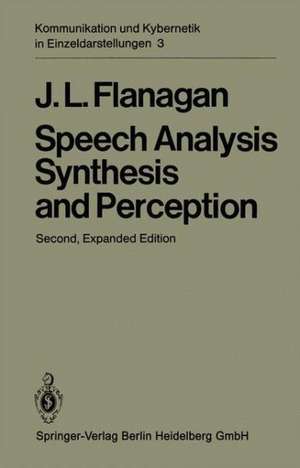Speech Analysis Synthesis and Perception: Communication and Cybernetics, cartea 3
Autor James L Flanaganen Limba Engleză Paperback – 11 oct 2012
Din seria Communication and Cybernetics
-
 Preț: 437.72 lei
Preț: 437.72 lei - 20%
 Preț: 645.31 lei
Preț: 645.31 lei - 15%
 Preț: 646.62 lei
Preț: 646.62 lei - 15%
 Preț: 642.83 lei
Preț: 642.83 lei -
 Preț: 379.86 lei
Preț: 379.86 lei - 15%
 Preț: 642.03 lei
Preț: 642.03 lei - 15%
 Preț: 639.41 lei
Preț: 639.41 lei -
 Preț: 489.87 lei
Preț: 489.87 lei -
 Preț: 383.71 lei
Preț: 383.71 lei -
 Preț: 383.93 lei
Preț: 383.93 lei -
 Preț: 398.74 lei
Preț: 398.74 lei -
 Preț: 410.94 lei
Preț: 410.94 lei - 20%
 Preț: 360.05 lei
Preț: 360.05 lei -
 Preț: 383.71 lei
Preț: 383.71 lei - 15%
 Preț: 647.08 lei
Preț: 647.08 lei - 15%
 Preț: 634.18 lei
Preț: 634.18 lei
Preț: 397.59 lei
Nou
Puncte Express: 596
Preț estimativ în valută:
76.09€ • 79.14$ • 62.82£
76.09€ • 79.14$ • 62.82£
Carte tipărită la comandă
Livrare economică 14-28 aprilie
Preluare comenzi: 021 569.72.76
Specificații
ISBN-13: 9783662015643
ISBN-10: 3662015641
Pagini: 460
Ilustrații: XI, 446 p. 151 illus.
Dimensiuni: 155 x 235 x 24 mm
Greutate: 0.64 kg
Ediția:Softcover reprint of the original 2nd ed. 1972
Editura: Springer Berlin, Heidelberg
Colecția Springer
Seria Communication and Cybernetics
Locul publicării:Berlin, Heidelberg, Germany
ISBN-10: 3662015641
Pagini: 460
Ilustrații: XI, 446 p. 151 illus.
Dimensiuni: 155 x 235 x 24 mm
Greutate: 0.64 kg
Ediția:Softcover reprint of the original 2nd ed. 1972
Editura: Springer Berlin, Heidelberg
Colecția Springer
Seria Communication and Cybernetics
Locul publicării:Berlin, Heidelberg, Germany
Public țintă
ResearchCuprins
I. Voice Communication.- 1.1. The Advent of Telephony.- 1.2. Efficient Transmission of Speech.- 1.3. Capacity of the Human Channel.- 1.4. Analysis-Synthesis Telephony: An Approach to Improved Efficiency.- II. The Mechanism of Speech Production.- 2.1. Physiology of the Vocal Apparatus.- 2.2. The Sounds of Speech.- 2.3. Quantitative Description of Speech.- III. Acoustical Properties of the Vocal System.- 3.1. The Vocal Tract as an Acoustic System.- 3.2. Equivalent Circuit for the Lossy Cylindrical Pipe.- 3.3. The Radiation Load at the Mouth and Nostrils.- 3.4. Spreading of Sound About the Head.- 3.5. The Source for Voiced Sounds.- 3.6. The Source for Noise and Transient Excitation of the Tract.- 3.7. Some Characteristics of Vocal Tract Transmission.- 3.8. Fundamentals of Speech and Hearing in Analysis-Synthesis Telephony.- IV. The Ear and Hearing.- 4.1. Mechanism of the Ear.- 4.2. Computational Models for Ear Function.- 4.3. Illustrative Relations between Subjective and Physiological Behavior.- V. Techniques for Speech Analysis.- 5.1. Spectral Analysis of Speech.- 5.2. Formant Analysis of Speech.- 5.3. Analysis of Voice Pitch.- 5.4. Articulatory Analysis of the Vocal Mechanism.- 5.5. Automatic Recognition of Speech.- 5.6. Automatic Recognition and Verification of Speakers.- VI. Speech Synthesis.- 6.1. Mechanical Speaking Machines; Historical Efforts.- 6.2. Electrical Methods for Speech Synthesis.- VII. Perception of Speech and Speech-Like Sounds.- 7.1, Differential vs. Absolute Discrimination.- 7.2. Differential Discriminations Along Signal Dimensions Related to Speech.- 7.3. Absolute Discrimination of Speech and Speech-Like Sounds.- 7.4. Effects of Context and Vocabulary upon Speech Perception.- 7.5. The Perceptual Units of Speech.- 7.6. Subjective Evaluation of Transmission Systems.- 7.7. Calculating Intelligibility Scores from System Response and Noise Level: The Articulation Index.- 7.8. Supplementary Sensory Channels for Speech Perception.- VIII. Systems for Analysis-Synthesis Telephony.- 8.1. Channel Vocoders.- 8.2. Reduced Redundancy Channel Vocoders.- 8.3. Voice-Excited Vocoders.- 8.4. Correlation Vocoders.- 8.5. Formant Vocoders.- 8.6. Orthogonal Function Vocoders.- 8.7. Homomorphic Vocoders.- 8.8. Maximum Likelihood Vocoders.- 8.9. Linear Prediction Vocoders.- 8.10. Articulatory Vocoders.- 8.11. Frequency-Dividing Vocoders.- 8.12. Time-Assignment Transmission of Speech.- 8.13. Predictive Coding of Speech.- 8.14. Delta Modulation.- References.- Author Index.




